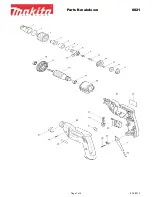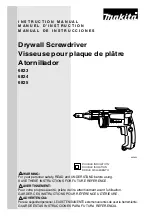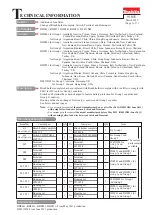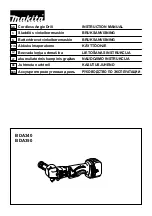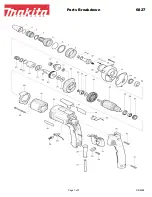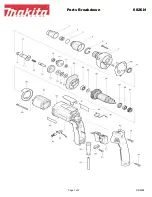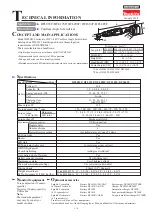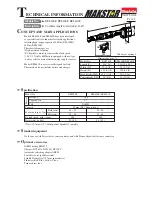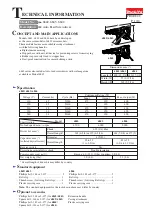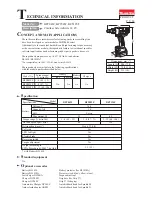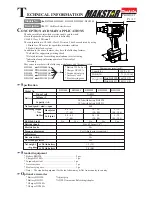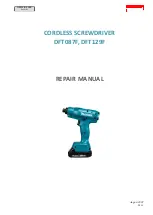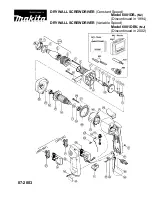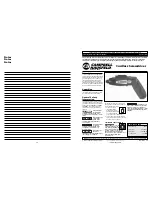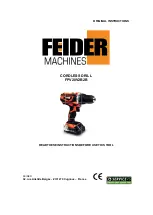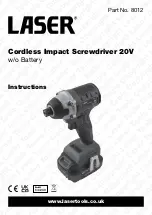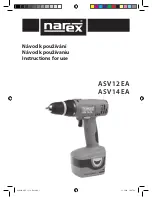
INSTRUCTION MANUAL
GUIDE D'UTILISA
TION
MANUAL
DE INSTRUCCIONES
INSTRUCTIVO DE OPERACIÓN, CENTROS DE SER
VICIO
Y
PÓLIZA
DE GARANTÍA.
ADVERTENCIA:
LÉASE ESTE INSTRUCTIVO
ANTES DE USAR EL
PRODUCT
O.
D
E
WALT Industrial Tool Co., 701 Joppa Road, Baltimore, MD 21286
(JUN04) Form No. 624833-00 DW979, DC520 Copyright © 2004
The following are trademarks for one or more D
E
WALT power tools: the yellow and black color scheme; the
“D” shaped air intake grill; the array of pyramids on the handgrip; the kit box configuration; and the array of
lozenge-shaped humps on the surface of the tool.
Questions? See us in the W
orld Wide W
eb at
www
.dewalt.com
DW979 12 V
olt Cordless Drywall/Deck Screwdriver
DC520 18 V
olt Cordless Drywall/Deck Screwdriver
DW979 T
ournevis sans fil de 12 volts pour cloisons sèches/terrasses
DC520 T
ournevis sans fil de 18 volts pour cloisons sèches/terrasses
DW979
Atornillador inalámbrico de 12 voltios para muro seco y placa de tablero
DW520
Atornillador inalámbrico de 18 voltios para muro seco y placa de tablero
IF YOU HAVE ANY QUESTIONS OR COMMENTS ABOUT THIS OR ANY D
E
WALT TOOL,
CALL US TOLL FREE AT:
1-800-4-D
E
WALT (1-800-433-9258)
General Safety Rules – For All Battery Operated Tools
WARNING! Read and understand all instructions.
Failure to follow all
instructions listed below may result in electric shock, fire and/or serious per-
sonal injury.
SAVE THESE INSTRUCTIONS
WORK AREA
•
Keep your work area clean and well lit.
Cluttered benches and dark areas invite accidents.
•
Do not operate power tools in explosive atmospheres, such as in the presence of flam-
mable liquids, gases, or dust.
Power tools create sparks which may ignite the dust or
fumes.
•
Keep bystanders, children, and visitors away while operating a power tool.
Distractions
can cause you to lose control.
ELECTRICAL SAFETY
•
Do not abuse the cord. Never use the cord to carry the tool. Keep cord away from heat,
oil, sharp edges or moving parts. Replace damaged cords immediately.
Damaged cords
may create a fire.
•
A battery operated tool with integral batteries or a separate battery pack must be
recharged only with the specified charger for the battery
. A charger that may be suitable
for one type of battery may create a risk of fire when used with another battery.
•
Use battery operated tool only with the specifically designated battery pack.
Use of any
other batteries may create a risk of fire.
PERSONAL SAFETY
•
Stay alert, watch what you are doing and use common sense when operating a power
tool. Do not use tool while tired or under the influence of drugs, alcohol, or medica-
tion.
A moment of inattention while operating power tools may result in serious personal
injury.
•
Dress properly. Do not wear loose clothing or jewelry. Contain long hair. Keep your
hair, clothing, and gloves away from moving parts.
Loose clothing, jewelry, or long hair
can be caught in moving parts. Air vents often cover moving parts and should also be avoid-
ed.
•
Avoid accidental starting. Be sure switch is in the locked or off position before insert-
ing battery pack.
Carrying tools with your finger on the switch or inserting the battery pack
into a tool with the switch on invites accidents.
•
Remove adjusting keys or wrenches before turning the tool on.
A wrench or a key that
is left attached to a rotating part of the tool may result in personal injury.
•
Do not overreach. Keep proper footing and balance at all times
. Proper footing and bal-
ance enables better control of the tool in unexpected situations.
•
Use safety equipment. Always wear eye protection.
Dust mask, non-skid safety shoes,
hard hat, or hearing protection must be used for appropriate conditions.
TOOL USE AND CARE
•
Use clamps or other practical way to secure and support the workpiece to a stable
platform.
Holding the work by hand or against your body is unstable and may lead to a loss
of control.
•
Do not force tool. Use the correct tool for your application.
The correct tool will do the
job better and safer at the rate for which it is designed.
•
Do not use tool if switch does not turn it on or off.
A tool that cannot be controlled with
the switch is dangerous and must be repaired.
•
Disconnect battery pack from tool or place the switch in the locked or off position
before making any adjustments, changing accessories, or storing the tool.
Such pre-
ventative safety measures reduce the risk of starting the tool accidentally.
•
Store idle tools out of reach of children and other untrained persons.
Tools are dan-
gerous in the hands of untrained users.
•
When battery pack is not in use, keep it away from other metal objects like: paper
clips, coins, keys, nails, screws, or other small metal objects that can make a con-
nection from one terminal to another.
Shorting the battery terminals together may cause
sparks, burns, or a fire.
•
Maintain tools with care. Keep cutting tools sharp and clean.
Properly maintained tools,
with sharp cutting edges are less likely to bind and are easier to control.
•
Check for misalignment or binding of moving parts, breakage of parts, and any other
condition that may affect the tool’s operation. If damaged, have the tool serviced
before using.
Many accidents are caused by poorly maintained tools.
•
Use only accessories that are recommended by the manufacturer for your model.
Accessories that may be suitable for one tool, may create a risk of injury when used on
another tool.
SERVICE
•
Tool service must be performed only by qualified repair personnel.
Service or mainte-
nance performed by unqualified personnel may result in a risk of injury.
•
When servicing a tool, use only identical replacement parts. Follow instructions in the
Maintenance section of this manual.
Use of unauthorized parts or failure to follow
Maintenance Instructions may create a risk of shock or injury.
Additional Specific Safety Rules
•
Hold tool by insulated gripping surfaces when performing an operation where the tool
may contact hidden wiring.
Contact with a “live” wire will also make exposed metal parts
of the tool “live” and shock the operator.
WARNING:
Some dust created by power sanding, sawing, grinding, drilling, and other con-
struction activities contains chemicals known to cause cancer, birth defects or other reproduc-
tive harm. Some examples of these chemicals are:
• lead from lead-based paints,
• crystalline silica from bricks and cement and other masonry products, and
• arsenic and chromium from chemically-treated lumber.
Your risk from these exposures varies, depending on how often you do this type of work. To
reduce your exposure to these chemicals: work in a well ventilated area, and work with
approved safety equipment, such as those dust masks that are specially designed to filter out
microscopic particles.
•
Avoid prolonged contact with dust from power sanding, sawing, grinding, drilling,
and other construction activities. Wear protective clothing and wash exposed areas
with soap and water.
Allowing dust to get into your mouth, eyes, or lay on the skin may pro-
mote absorption of harmful chemicals.
WARNING:
Use of this tool can generate and/or disburse dust, which may cause serious and
permanent respiratory or other injury. Always use NIOSH/OSHA approved respiratory protection
appropriate for the dust exposure. Direct particles away from face and body.
CAUTION: Wear appropriate hearing protection during use.
Under some conditions and
duration of use, noise from this product may contribute to hearing loss.
CAUTION: When not in use, place tool on its side on a stable surface where it will not
cause a tripping or falling hazard.
Some tools with large battery packs will stand upright on
the battery pack but may be easily knocked over.
• The label on your tool may include the following symbols. The symbols and their definitions
are as follows:
V................volts
A ....................amperes
Hz..............hertz
W....................watts
min ............minutes
..................alternating current
..........direct current
no ..................no load speed
..............Class II Construction
....................earthing terminal
..............safety alert symbol
.../min ............revolutions per minute
sfpm ..........surface feet per minute
Important Safety Instructions for Battery Packs
Your tool uses a D
E
WALT battery pack. When ordering replacement battery packs, be sure to
include catalog number and voltage: Extended Run-Time battery packs deliver 25% more run-
time than standard battery packs. Consult the chart at the end of this manual for compatibility of
chargers and battery packs.
NOTE:
Your tool will accept either standard or Extended Run Time battery packs. However, be
sure to select proper voltage. Batteries slowly lose their charge when they are not on the charg-
er, the best place to keep your battery is on the charger at all times.
The battery pack is not fully charged out of the carton. Before using the battery pack and charg-
er, read the safety instructions below. Then follow charging procedures outlined.
READ ALL INSTRUCTIONS
•
Do not incinerate the battery pack even if it is severely damaged or is completely worn
out.
The battery pack can explode in a fire.
•
A small leakage of liquid from the battery pack cells may occur under extreme usage
or temperature conditions.
This does not indicate a failure. However, if the outer seal is bro-
ken and this leakage gets on your skin:
a. Wash quickly with soap and water.
b. Neutralize with a mild acid such as lemon juice or vinegar.
c. If battery liquid gets into your eyes, flush them with clean water for a minimum of 10 min-
utes and seek immediate medical attention. (
Medical note:
The liquid is 25-35% solution
of potassium hydroxide.)
•
Charge the battery packs only in D
E
WALT chargers.
•
DO NOT
splash or immerse in water or other liquids.
•
Do not store or use the tool and battery pack in locations where the temperature may
reach or exceed 105°F (40 ºC) (such as outside sheds or metal buildings in summer).
DANGER:
Never attempt to open the battery pack for any reason. If battery pack case is
cracked or damaged, do not insert into charger. Electric shock or electrocution may result.
Damaged battery packs should be returned to service center for recycling.
NOTE
: Battery storage and carrying caps are providedfor use whenever the battery
is out of the tool or charger. Remove cap before placing battery in charger or tool.
WARNING: Do not store or carry battery so that metal objects can contact
exposed battery terminals.
For example, do not place battery in aprons, pockets,
tool boxes, product kit boxes, drawers, etc., with loose nails, screws, keys, etc. with-
out battery cap.
Transporting batteries can possibly cause fires if the battery
terminals inadvertently come in contact with conductive materials such as keys, coins,
hand tools and the like.
The US Department of Transportation Hazardous Material Regulations
(HMR) actually prohibit transporting batteries in commerce or on airplanes (i.e., packed in suit-
cases and carry-on luggage) UNLESS they are properly protected from short circuits. So when
transporting individual batteries, make sure that the battery terminals are protected and well
insulated from materials that could contact them and cause a short circuit.
CAUTION:
Battery pack must be securely attached to tool. If battery pack is detached, per-
sonal injury may result.
The RBRC™ Seal
The RBRC™ (Rechargeable Battery Recycling Corporation) Seal on the nickel-
cadmium battery (or battery pack) indicates that the costs to recycle the battery (or
battery pack) at the end of its useful life have already been paid by D
E
WALT. In some
areas, it is illegal to place spent nickel-cadmium batteries in the trash or municipal
solid waste stream and the RBRC program provides an environmentally conscious
alternative.
RBRC in cooperation with D
E
WALT and other battery users, has established programs in the
United States to facilitate the collection of spent nickel-cadmium batteries. Help protect our envi-
ronment and conserve natural resources by returning the spent nickel-cadmium battery to an
authorized D
E
WALT service center or to your local retailer for recycling. You may also contact
your local recycling center for information on where to drop off the spent battery.
Important Safety Instructions for Battery Chargers
SAVE THESE INSTRUCTIONS:
This manual contains important safety instructions for battery
chargers.
•
Before using charger, read all instructions and cautionary markings on charger, battery pack,
and product using battery pack.
DANGER:
120 volts are present at charging terminals. Do not probe with conductive objects.
Electric shock or electrocution may result.
WARNING:
Do not allow any liquid to get inside charger. Electric shock may result.
CAUTION:
To reduce the risk of injury, charge only D
E
WALT nickel cadmium rechargeable
batteries. Other types of batteries may burst causing personal injury and damage.
CAUTION:
Under certain conditions, with the charger plugged in to the power supply, the
exposed charging contacts inside the charger can be shorted by foreign material. Foreign mate-
TRIGGER SWITCH
INTERRUPTEUR À DÉTENTE
GATILLO INTERRUPTOR
FORWARD/REVERSE BUTTON
INVERSEUR DE MARCHE
SELECTOR DE MARCHA HACIA
ADELANTE/REVERSA
BIT HOLDER
PORTE-LAMES
SUJETADOR DE PUNTAS
DEPTH
LOCATOR
LIMITEUR DE
PROFONDEUR
SENSOR DE
PROFUNDIDAD
BATTERY PACK
ENSEMBLE DE PILES
BATER
ÍA
ÍA
ADJUSTMENT COLLAR
BAGUE DE RÉGLAGE
COLLAR DE AJUSTE
TRIGGER SWITCH
INTERRUPTEUR À DÉTENTE
GATILLO INTERRUPTOR
FORWARD/REVERSE BUTTON
INVERSEUR DE MARCHE
SELECTOR DE MARCHA HACIA
ADELANTE/REVERSA
BIT HOLDER
PORTE-LAMES
SUJETADOR DE PUNTAS
DEPTH
LOCATOR
LIMITEUR DE
PROFONDEUR
SENSOR DE
PROFUNDIDAD
BATTERY PACK
ENSEMBLE DE PILES
BATER
ÍA
ÍA
ADJUSTMENT COLLAR
BAGUE DE RÉGLAGE
COLLAR DE AJUSTE
DW979
DC520








